Collective Study (Issue 01) | Questions Over Tibet Quake Casualties | US Govt-Approved Geographic Labels Spread CCP’s Tibet Terminology | Party Mouthpiece Urges GenAI Fakes Crackdown | Politics of Language Oppression
Welcome to the first issue of Collective Study!
I hope you will find this to be a useful source for news, research and commentary on human rights and authoritarianism in the PRC.
You can subscribe for free, view this email online, and follow Collective Study on Bluesky.
1. Questions Over Tibet Quake Casualty Figures
Within a day of the 6.8 quake that struck Shigatse (གཞིས་ཀ་རྩེ་གྲོང་ཁྱེར། / 日喀則) in Tibet on the 7th of January PRC authorities stopped updating the death toll.
Official statements and reporting suggest a number of reasons to be concerned about potential undercounting.
Let’s review a timeline of Xinhua’s key reporting from the first day of the disaster:
- Jan 7 - 09:23 - Xinhua’s first news alert reported a 6.8 magnitude quake hit Dingri County (དིང་རི་རྫོང / 定日縣) in Shigatse at 09:05 that morning at a depth of 10 kilometres. Xinhua later reported there was a population of “about 6900” living within 20 km of the epicentre.
- Jan 7 - 10:05 - Dingri County mayor said tremors were “particularly strong”.
- Jan 7 - 10:36 - Casualties reported, without any estimate.
- Jan 7 - 12:37 - First official casualty toll: 32 people dead and 38 injured, as of 11:50.
- Jan 7 - 13:02 - Second casualty toll: 53 dead and 62 injured in Dingri County, as of 12:30.
- Jan 7 - 13:10 - Xi Jinping issued instructions on responding to the quake. Xi’s instructions referred to the quake as having “caused major casualties” (造成重大人员伤亡).
- Jan 7 - 16:05 - Third casualty toll: 95 dead and 130 injured, as of 15:00.
- Jan 7 - 19:02 - The Ministry of Emergency Management raised the national disaster rescue and emergency response level to level 2.
- Jan 7 - 22:10 - Fourth casualty toll: 126 dead, 188 injured and 28 seriously people transferred to hospital; 3609 houses collapsed, as of 19:00.
(Dates and times above all in Beijing time and given according to the earliest version of the report available on Xinhua’s website www.news.cn. Slightly earlier versions possibly exist on other platforms Xinhua might publish to.)
Remarkably, given the scale and location of the disaster, Xinhua has not reported any changes to the death toll since the evening of the 7th.
Two days after the quake the numbers of people affected by the disaster reached 61,500, according to Xinhua. That is around 9x the number of people Xinhua had earlier reported lived within 20km of the epicentre, revealing how destructive the quake had been.
On the 11th, CCTV reported a total of 338 people had been admitted to medical institutions, with 244 having been discharged as of noon that day. Yet official reporting, including a Xinhua recap of the first 48 hours following the quake, contain details that might cast doubt on these official figures.
Firstly, Xinhua reported 407 trapped people had been freed as of the 9th. How many, if any, of these 407 people are included in the official toll of 338 injured people treated in medical institutions? What are the chances people trapped in temperatures well below freezing all dusted themselves off and went on their way unharmed? More glaringly, no estimate is provided for the number of people injured who were not admitted for treatment.
By the time Xinhua published a 7 day recap feature on the 14th it appeared equally confused, choosing to completely omitted any figures for the number of injured. Instead the agency shared that 126 people died, 27,248 houses were damaged, 3612 collapsed, and around 61,500 people were “affected by the disaster to different degrees”.
Xinhua nevertheless triumphantly declared that “earthquake relief work on the roof of the world shows China's speed and warmth”. According to the modest report, “many overseas internet users” posted comments praising the “extremely effective rescue operation” and observing how “not many countries could complete logistics and organisational work on such a scale in such a short time”. If you have seen these comments do get in touch.
The state media celebrations were perhaps premature. Authorities announced soon after that around 1,500 Dingri County residents had to be evacuated to higher ground due to tilting walls at a damaged hydropower dam. Official inspections of 14 hydropower dams in Tibet following the 6.8 quake found that five had problems including cracks, of which three had to be drained, Reuters reported.
2. US Government-Approved Geographic Labels Spread CCP’s Tibet Terminology
Earthquakes like the one that struck Tibet on the 7th of January 2025 trigger automated alerts to people around the world via various platforms including government sites and social media. These alerts ultimately draw from databases of geographic labels which inform people about where quakes hit.
However in the case of Tibet, the labels often refer to ‘Xizang’ (西藏) rather than ‘Tibet’. ‘Xizang’ is the standard Mandarin Chinese term for Tibet. It’s also a term the CCP increasingly wants to promote abroad to influence how people talk and think about all things Tibet, not least human rights.
This all means that as reports of quakes in Tibet spread throughout the internet, so too does terminology that supports the CCP’s external propaganda work and serves as "a tool of erasure".
When Collective Study approached a social media user with a large following about why they had used the term ‘Xizang’ in their posts about the quake, the response was that the term came from the US government. ‘Xizang’ indeed appeared in multiple US Geological Survey (USGS) pages about the quake. Likewise, we see ‘Xizang’ terminology in other scientific data providers, including in Europe and India. For our purposes, however, we'll look at USGS.
USGS is an agency of the US Department of the Interior that aims "to provide objective and impartial science" and is a "primary Federal source of science-based information," according to its homepage. The agency provided the following response to a query from Collective Study about USGS's use of ‘Xizang’ and whether it might be replaced by ‘Tibet’ given concerns outlined above:
‘The USGS earthquake program tries to provide users with a rich experience and pulls geographic data from several different sources, so it is hard to be consistent with all the geographic names.
We have manually updated the "names" of events in the recent sequence to "Tibetan Plateau" but don't have the tools to update all historic events names.
Names considered for official use by the US Government are defined by the Board of Geographic Names.
Xizang, it is an approved name for the region, according to the U.S. Board on Geographic Names (BGN). Tibet is also approved as a Conventional Name by BGN, so either one is officially correct, as far as US Government policy is concerned. However, to address the concerns such as the ones you mentioned we have updated the recent names manually as stated above.’
The U.S. Board on Geographic Names (BGN) referenced by the official is “a Federal body created in 1890 and established in its present form by Public Law in 1947 to maintain uniform geographic name usage throughout the Federal Government,” its official site states.
Foreign place names approved by the Board are officially put into the Geographic Names Server (GNS) which is developed and maintained by the US National Geospatial-Intelligence Agency. That agency “leads the Department of Defense and intelligence community in the production, procurement, assessment and cataloging of geospatial data,” according to its homepage.
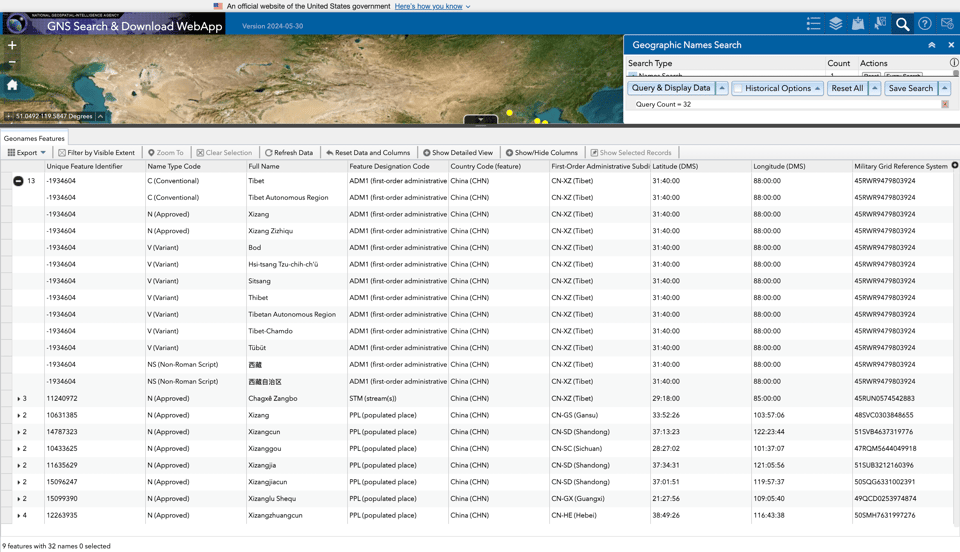
As both ‘Tibet’ and ‘Xizang’ are approved terms in GNS, it is not immediately clear why the USGS site would be populated with ‘Xizang’ over ‘Tibet’.
Elsewhere on the USGS site we see ‘western Xizang’ listed as the FE region of the quake. ‘FE region’ refers to the Flinn-Engdahl Regionalisation Scheme. That scheme, last revised in the mid 1990s exclusively uses ‘Xizang’ in place of ‘Tibet’.
For anyone who wants to spend more time than Collective Study has to look into this, the history of the drafting of the FE regions could be another line of enquiry. The scheme is said to be in use at all seismological data centres.
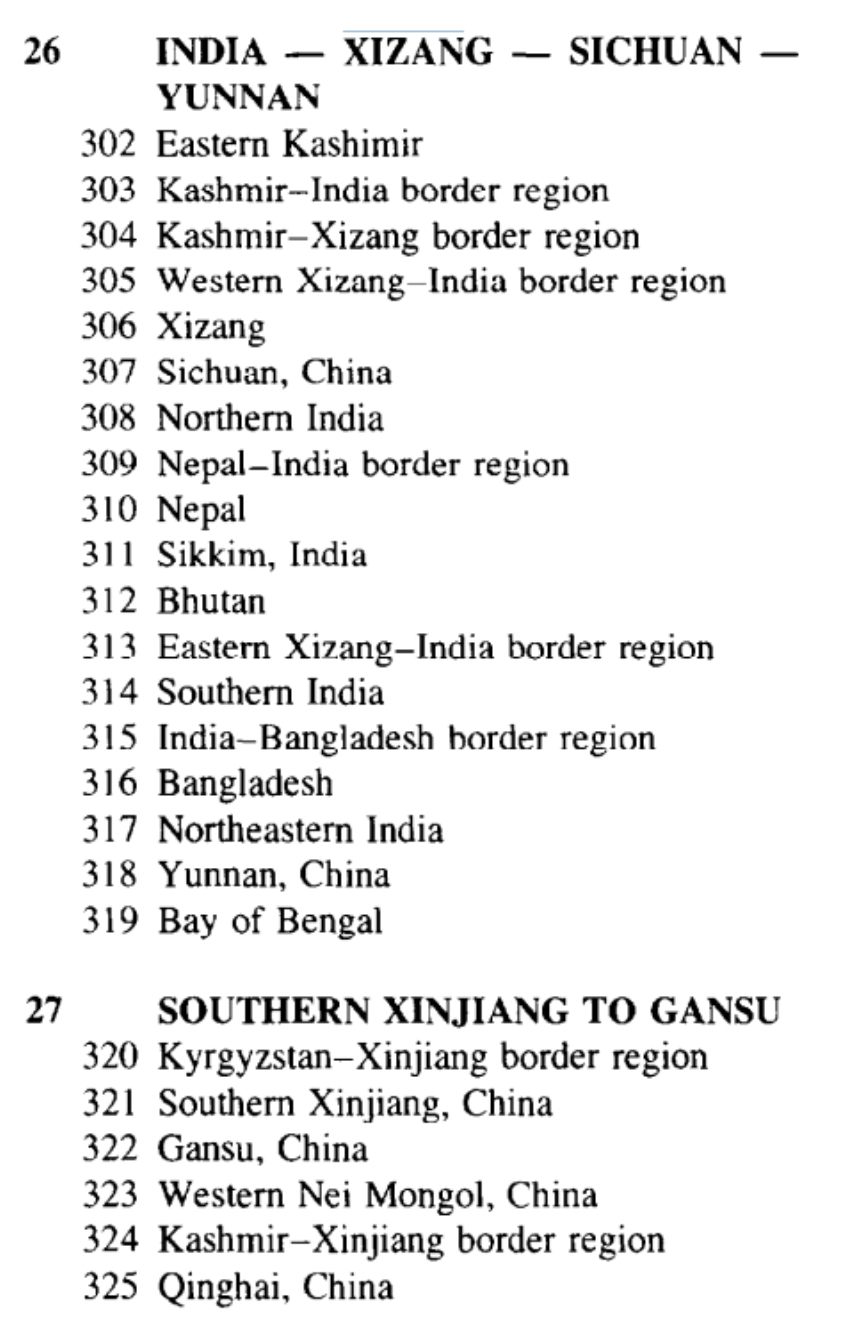
If we go further back to Flinn and Engdahl’s 1965 paper that proposed the system, we find no mention of 'Xizang'. Instead, 'Tibet' is used for all Tibet-related labels. “Names adopted for geographical regions are geographical wherever possible and the spelling follows the National Geographic Society (1963) Atlas,” the authors noted. As for seismic region names, the authors stated they followed Gutenberg and Richter's (1954) definitions with modifications.
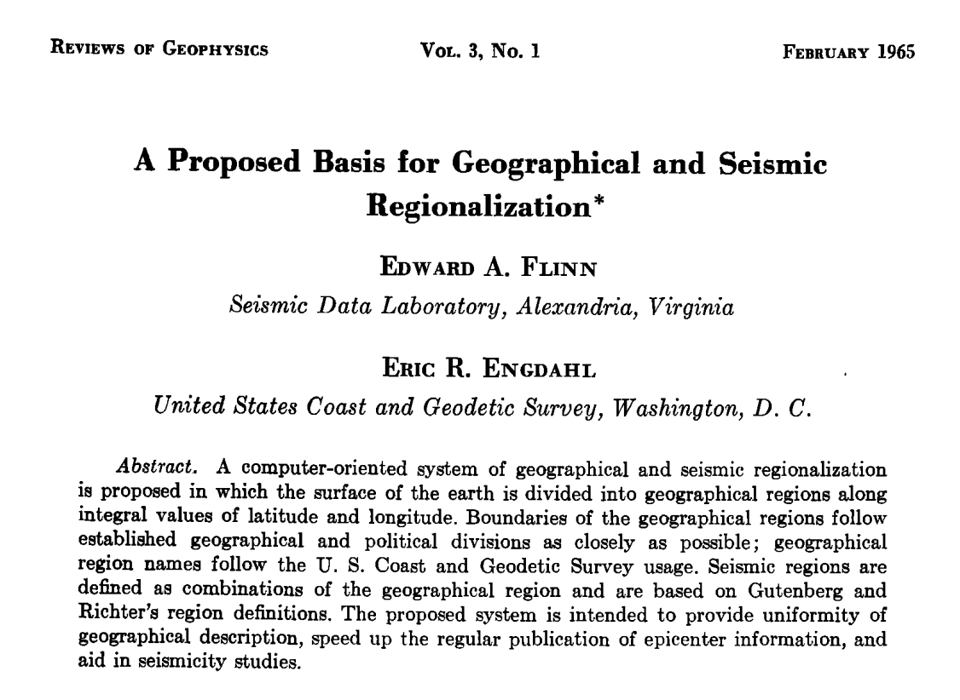


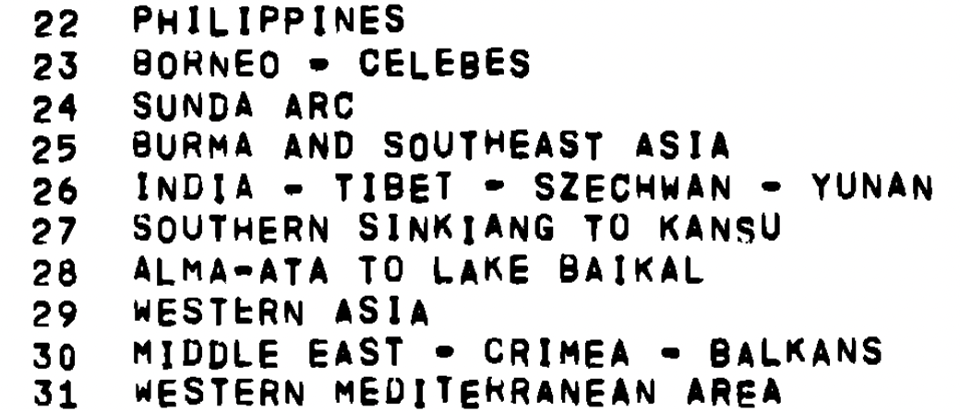
The US government’s use of ‘Xizang’ geographic labels on public-facing websites in the current context however seems incompatible with multiple parts of its recent Tibet Resolve Act, signed by President Biden in July 2024, specifically the Act’s emphasis on countering PRC disinformation about Tibet and the PRC’s suppression of Tibetan culture, history, and environment.
Stakes are increasingly high given the PRC’s increased efforts to promote ‘Xizang’ as the internationally accepted term for Tibet.
In recent years this effort has formed a distinct propaganda campaign that ultimately seeks to weaken or erase Tibet’s distinct cultural identities and subsume them into CCP colonial concepts such as the ‘Community for the Chinese nation‘ (中华民族共同体).
A United Front Work Department (UFWD) account cheered in August 2023 that there was no more ‘Tibet’ in official documents of the Ministry of Foreign Affairs, and later that autumn ‘Xizang’ was used in the English version of a speech by Wang Yi, Radio Free Asia (RFA) reported at the time. Adopting ‘Xizang’ would help strike “separatist forces” and “enhance China’s international discourse power on Tibet,” according to PRC propaganda workers and scholars quoted in the UFWD piece.
This propaganda campaign appears to be scoring success overseas too. The British Museum used ‘Tibet or Xizang Autonomous Region’ in an exhibition that opened in September, according to a RFA report. The RFA report also highlighted cases of French museums, including the famous Musée du Quai Branly-Jacques Chirac in Paris, which had adopted PRC-friendly terminology including ‘Xizang’. An official from Musée du Quai Branly-Jacques Chirac later met with Tibetan organisations, apologised, and agreed to replace ‘Xizang’ labels with Tibet, the RFA report added.
It is important for foreign governments to understand that ‘Xizang’ and ‘Tibet’ are not interchangeable terms.
Helpfully, the Resolve Tibet Act clarifies what exactly is meant by ‘Tibet’ for the US. In a new section the Resolve Tibet Act adds to the The Tibetan Policy Act of 2002, ‘Tibet’ is defined as referring to ‘The Tibet Autonomous Region’ as well as areas outside the Tibetan Autonomous Region that the PRC government has designated as ‘Tibetan Autonomous’, including in Yunnan, Gansu, Qinghai and Sichuan provinces. That should mean ‘Tibet’ refers neither to ‘Xizang’ nor ‘Xizang Autonomous Zone’, and neither should ‘Xizang’ be viewed as an acceptable alternate name for Tibet.
The next US Special Coordinator for Tibetan Issues (assuming one will be appointed by the Trump administration), should, in line with the text of the Resolve Tibet Act, “work with relevant bureaus of the Department of State and the United States Agency for International Development to ensure that United States Government statements and documents counter, as appropriate, disinformation about Tibet from the Government of the People's Republic of China and the Chinese Communist Party, including disinformation about the history of Tibet, the Tibetan people, and Tibetan institutions, including that of the Dalai Lama”.
Ensuring that US government agencies or US-funded entities do not unintentionally enable or give the appearance of support for the international spread of ‘Xizang’ could be a simple step on this important mission.
3. Party Mouthpiece Urges GenAI Fakes Crackdown After Viral Tibet Quake Baby Images
Qinghai police detain GenAI image sharer and Party mouthpiece lashes out after viral AI-generated image showed a baby trapped in rubble
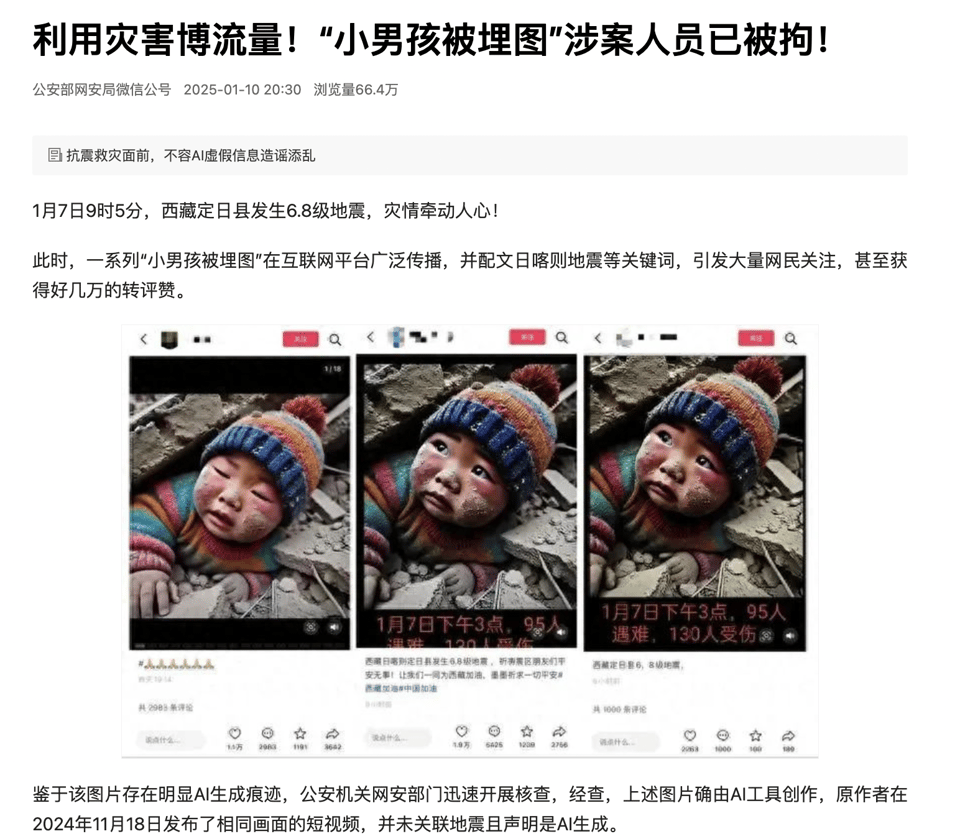
Chinese police detained an internet user in Qinghai for sharing a GenAI image of a baby lying in rubble and linking it to the Jan 7 quake. The unnamed individual, who was being held under administrative detention, “misled the public, causing rumours to spread,” according to a Jan 10 article on the WeChat account of the Cybersecurity Bureau of the Ministry of Public Security (公安部網安局).
Police claimed that related posts were shared, commented on and liked tens of thousands of times. In the most serious of cases, spreading fake information can result in a prison sentence of up to 7 years under PRC criminal law, the article warned.
The image of the child was however generated by a different person back in November, before the quake, according to the police article. There was no mention of any punishment for the image’s creator, who police explained had clearly labelled their image as AI-generated.
The CCP’s propaganda apparatus meanwhile was going all out in generating its own variety of manipulated quake coverage.
Leading propaganda outlets like Xinhua and People’s Daily led with carefully screened images of young quake victims smiling or receiving supplies. A number of state media reports explicitly used the word ‘heartwarming’ in their titles, in case there was any doubt over the intended function of these pieces. One powerfully symbolic video highlighted that a group of Tibetan children wanted to watch Wolf Warrior upon getting an internet TV signal in a prefabricated cabin where they had been resettled after the quake.
The GenAI fake image of a child trapped in rubble risked undermining this chorus of positive energy.
“In the face of earthquake relief efforts, AI fake information creating rumours and causing trouble will not be tolerated,” warned a People’s Daily ‘sharp commentary’ on Jan 10. “Don’t let rumours become a ‘secondary disaster’ of the quake,” cautioned another PD piece the same day.
That first People's Daily commentary attacked AI generated image sharing practices and platforms and called for greater regulation. “[We] must step up the crackdown on this kind of false [GenAI] information so that those who want to use disasters to get clicks will not dare have such crooked thoughts,” it argued.
While noting the potential for GenAI fakes to disrupt rescue operations, the commentary also worried how the images might “divert the focus of public opinion and create false negative public sentiment” and “disrupt social order”. Other concerns about GenAI, including copyright and environmental harms, were not addressed.
Surely there’s enough room inside the Great Firewall for both the CCP’s real fakes and netizens’ fake fakes? Whatever happened to the socialist marketplace of ideas?
If we take a look at the broader context however, can we say the CCP's fears over AI-generated images are like those of other states? If the PRC authorities are concerned with the truth of events in Tibet, why can foreign media not visit without special permission?
Perhaps where the GenAI user went wrong was less in depicting events that didn’t happen, and more in showing a disregard for the CCP’s monopoly on depictions of Tibetan people.
4. Politics of Language Oppression in Tibet
Listen (or read the soon-to-be-published transcript) to an interview with Dr. Gerald Roche about his new book The Politics of Language Oppression in Tibet.
You can also find the interview by searching for the ‘New Books in Human Rights’ and ‘New Books in Chinese Studies’ podcasts in your favourite apps.
***
Questions? Comments? Corrections? collectivestudysession@protonmail.com
